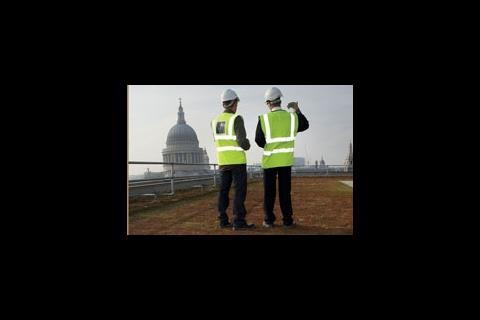Two recent stories, one arguing for and against the green credentials of PVCu, and the other on the safety of green roofs has sparked off some heated debateŌĆ”
How green is PVCu?
Paul Roche, director of sustainable products at SIG wrote:
Information on sustainable products is often confusing and contradictory, as illustrated by the greener-than-thou spat raging between the timber lobby and the PVCu industry ().
This is a debate that could continue to rage for years, and will ultimately get us nowhere. Sustainability is not an exact science, so why should we expect our ratings systems and accreditations to perform like one?
Surely the point of developing sustainable buildings is to reduce the amount of carbon dioxide they emit, reducing the effects of climate change.
Currently, 70% of energy incorporated within a building is operational. Therefore it makes sense to address this first, giving manufacturers the time and opportunity to address embodied energy, which will be the main consideration once we reach the stage of developing zero-carbon buildings.
There is a long way to go before we can take the purist view. Staying focused on developing and promoting realistic and practical sustainable options that provide clients with tangible environmental and economic benefits is more likely to lead to sustainable solutions being adopted on a wider scale.
One thing is for certain: ŌĆ£Replace your existing windows with FSC-approved timber windowsŌĆØ is not a call to action to which many households will respond positively.
The only significant response it would likely elicit is for the majority opting to stick with what theyŌĆÖve got, along with their current CO┬▓ levels.
Paul Jervis, consultant technical executive at British Plastics Federation Windows Group wrote:
PVC-U windows performed well because the PVC industry has worked hard to reduce its environmental footprint and because BRE took a scientific approach to cradle to grave life cycle assessment including 13 detailed environmental impact categories. It is still little known outside the industry that many thousands of tonnes of used PVC-U windows are being recycled every year.
║├╔½Ž╚╔·TV reader, John Easton wrote:
Interesting to note that with a recent update to LEED the US Green ║├╔½Ž╚╔·TV Council has for the first time introduced credits for the exclusion of PVC from buildings, despite strong lobbying and potential legal challenges from petrochemical vested interests.
And in California the state government has now banned PVC from toys due to the perceived health risks to children. How long before this experience informs our decision making here?
Insurers warn off fire risk from green roofs
Tim Wood of Permanite Engineered Roofing Systems wrote:

In response to your story there is little, if any, evidence to suggest that green roofs significantly increase the risk of fire.
On the contrary, it can be argued that, in the case of properly installed green roofs that include simple techniques such as fire breaks and the latest generation of fire retardant waterproofing, the risk of fire from roof vegetation is actually less than the risk of fire from the vegetation that surrounds the base of the building.
There is already strong evidence from European manufacturers that suggests green roofs can actually slow the spread of fire through the roof. With correct installation and choice of materials, the risk is further lessened.
Contrary to Mr BlackieŌĆÖs assumption that ŌĆ£the issue of fire spread, combustibility and fire safety is overlookedŌĆØ, the reality is that there are manufacturers, designers and installers who understand very well that fire safety is paramount.
Nobody can deny that vegetation presents a fire risk, but unlike California, the UK does not see many brush fires, just as we do not see green roof fires. But even this minimal risk can be effectively addressed by careful planning and the correct choice of materials.
Green roofs are an important sustainable technology that delivers many environmental and social benefits and has virtually no negatives. It would be a tragedy if this technology were jeopardised by the insurance industry.
Mark Harris of Sarnafil wrote:
As a roofing materials supplier that prides itself on managing risk, and helping our clients manage their risk, I have to agree with Dusty - this is too large a generalisation by Zurich.
Available evidence demonstrates that correctly designed and installed fire risk is mitigrated by a green roof. We have fire tested our extensive sedum based green roofing system to BS 476 Part 3 and achieved an FAA rating. As part of the test regime these samples were conditioned by the BRE prior to testing, resulting in drying of the test sample. The use of a growing medium partly based on crushed brick build up clearly contributing to the excellent fire performance.
The potential problems lie in a lack of understanding leading to poor design, the use of incorrect materials and/or incorrect installation. To combat these issued the roofing and horticultural industry have come together to from the Green Roof Advisory Board. This body is now working with Livingroofs.org and Sheffield University to put together guidance documents. GRAB already has representation from the CIC and the main roofing trade associations and would welcome representation from the insurance industry.
Green roofing provides the construction industry with the opportunity to help tackle climate change and mitigate flood risk. Lets not waste these opportunities by scaring people away from wanting them through a lack of knowledge.
║├╔½Ž╚╔·TV reader, Adam Dawson wrote:
Not to be too cynical, but if the risk is higher do you generally have to pay more for insurance? Besides surely planting mediums and soil maintain higher moisture content and are less flamable, not that I should generalise...
Anyway, green roofs are essentially the only design we have that maintains a stable external micro-climate, it is still massively underestimated in our efforts to improve sustainability as this single characteristic increases the life span of the building by reducing thermal movement in the building materials and elements. It also reduces internal environmental control requirements.
We have an immature market in the UK, and there is a risk we will try and re-invent the wheel, taking advice from overseas is not something to be ashamed of.
Postscript
The first letter is in response to an article entitled written by Stephen Kennett, published 5 September 2008, in ║├╔½Ž╚╔·TV magazine. This second letter is in response to a news story that appeared in ║├╔½Ž╚╔·TV magazine also on 5 September 2008 entitled written by Michael Willoughby.




























1 Readers' comment